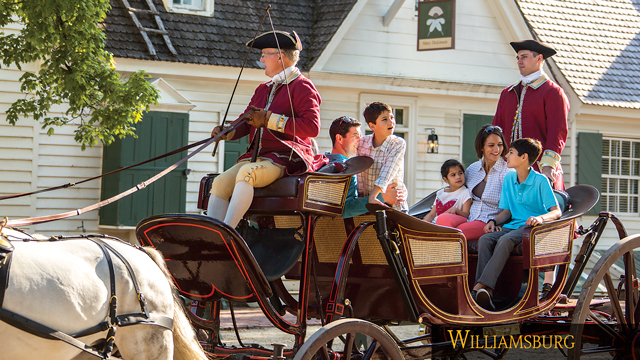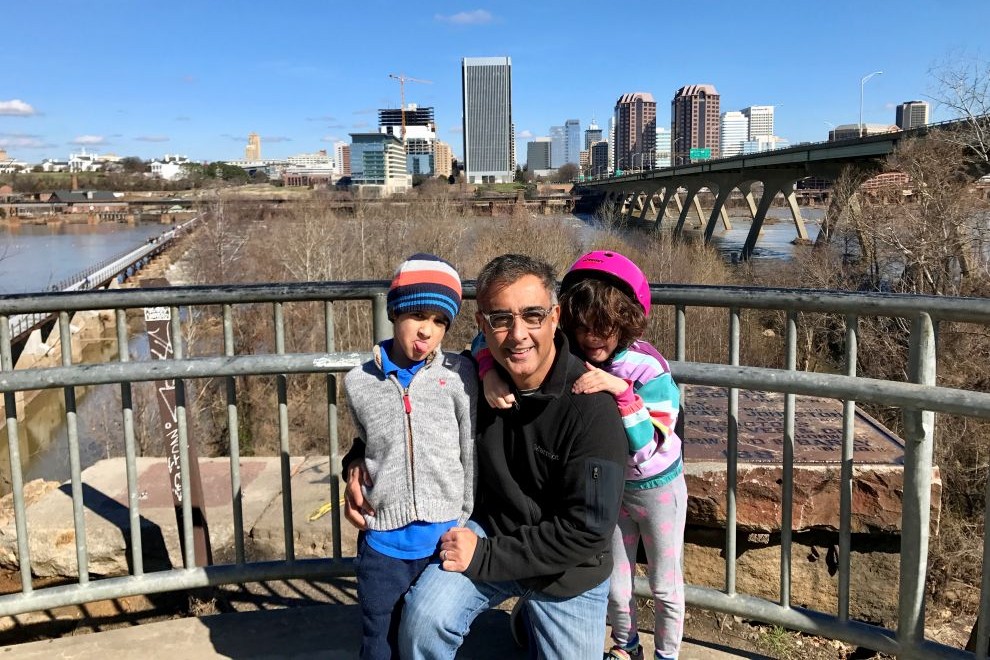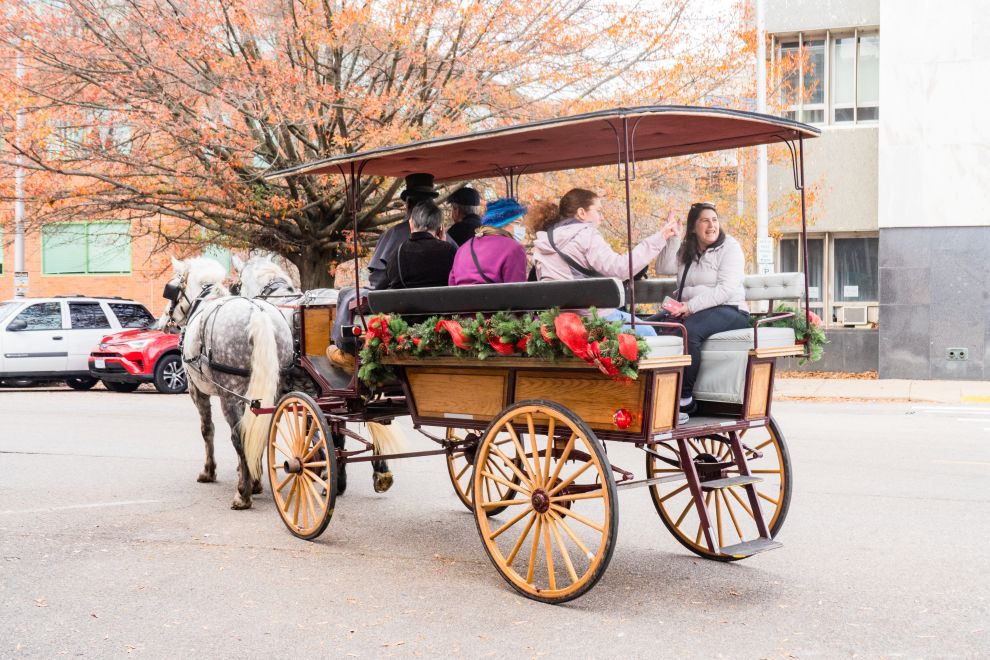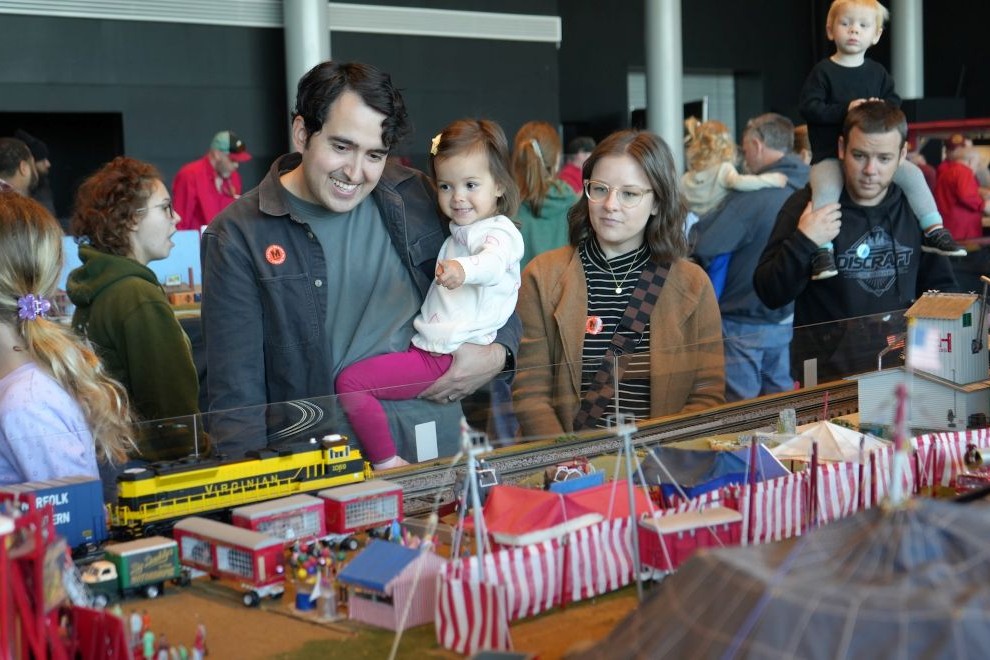With pass-holder access to Historic Colonial Williamsburg, my family and I make frequent trips to one of the largest living history museums in Virginia, discovering something new about the past each time we go. Through our numerous visits, my son and daughter have learned about the beginnings of our country’s democratic government and criminal justice system, thanks to tours of the Governor’s Palace, the Capitol Building, the Public Gaol (or jail), and the Courthouse. The kids were quite amused to see their father playing the part of a juror during a criminal trial demonstration. Together, the four of us have also experienced what it was like to be an apothecary, a blacksmith, a gardener, and a printer of The Virginia Gazette, one of the oldest newspapers in America, which began publishing in 1736.
Knowledge of the past – whether it’s a family’s personal history or how our commonwealth or country came to be – helps children develop a better understanding and appreciation of the present, as well as hope for the future. Studying history has other benefits, too. History provides us with a sense of identity, improves our decision-making and judgment skills as we learn from other people’s decisions, helps us with critical thinking and problem-solving, and shows us how to be better citizens and role models for future generations.
When it comes to learning about history, some kids grasp concepts easier through hands-on activities and demonstrations rather than reading a textbook or listening to a lecture. There are plenty of opportunities to experience the days gone by at museums throughout Virginia where history literally comes alive.
Ryan Stein, a father of two, history buff, educator, and principal of Greenwood Elementary School in Henrico County, is a firm believer in field trips to enhance history lessons. Interacting with historical interpreters and watching reenactments of historical events can be powerful and emotional for kids, according to Stein.
Taking a step back in time during a visit to a living history venue and seeing how someone from a particular era lived day-to-day can be especially meaningful for children, who might want to talk about historical events and put them into context.
“We can learn so much from the past,” Stein says. “I love all the stories. I love learning about other people, and incorporating their lessons into my own life. It makes me want to be a better person,” says Stein. “Virginia history, in particular, is wonderful. We are so fortunate to have so many places we can visit.”

Here in Virginia, we can experience what life was like during Colonial times, during the American Revolution, and during the Civil War. While students can visit historical sites on class trips, it’s just as important for children to engage in history with their families outside of school.
“The more a parent is involved, the more children will be excited about learning, whether it is going to a science museum, the library, or the Appomattox Courthouse,” says Stein.
Anne Price-Hardister, the on-site education program manager for the Jamestown-Yorktown Foundation (which includes Jamestown Settlement and the American Revolution Museum at Yorktown), echoes that sentiment.
“Parents who participate and discover something new with their children are enriching their children’s lives tremendously,” she says.
At Jamestown Settlement, families can climb aboard replicas of the Susan Constant, Godspeed, and Discovery, the three ships that brought the first English colonists to America in 1607. Guests can also experience what life was like for the colonists and the Native Americans by exploring life-size recreations of the colonists’ fort and the Powhatan village.
“We provide a setting for people to relate to the past,” says Price-Hardister. “Some people connect better to the past through these settings than through a book. Our goal is to make history come alive.”
My children and I have enjoyed plenty of trips to Jamestown Settlement starting from when they were in preschool. While there, the kids envisioned themselves as English boat captains as they steered the wheels on the three ships, and imagined what it was like to sleep on a bed of deerskin during an exploration of the Powhatan dwellings called yehakins. They also had the opportunity to grind corn and scrape out hollowed trees using oyster shells as tools to make canoes with the Native American interpreters, and don armored vests and hats while visiting the colonists’ fort.
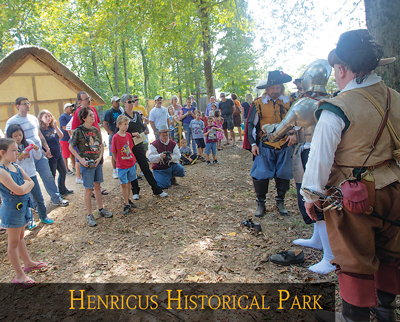
Both Jamestown Settlement and the American Revolution Museum at Yorktown offer programs for homeschoolers and preschoolers, as well as a newer program called Dig Deeper for older students to help acquire skills in cooperative learning, critical thinking, and problem-solving. Dig Deeper programs at Jamestown Settlement enable older children to start a fire with the Native Americans, be a part of the sailing crew on the three replica ships, solve a crime in the fort, or build a wall as they compare the home-building techniques of the Englishmen and the Powhatans. Jamestown Settlement also honors the food and cooking culture of both the colonists and the Native Americans each November with demonstrations during the annual Foods and Fests of Colonial Virginia over the Thanksgiving weekend.
The chance to explore, ask questions, and attempt to look at life through the eyes of the people who lived in the past is beneficial for the whole family.
“Working together to complete a task – like scraping out the canoes with the shells – gives families a sense of accomplishment,” says Price-Hardister. “That is part of the enjoyment of history. We learn that the people of the past were a lot like the people today.”
Christie Cali, a Chesterfield mother who homeschools, treks with her family to historical sites throughout the commonwealth.
“We are highly blessed here in Virginia with the opportunity to visit historical sites of all sorts,” Cali says. “As a home educator, I have been able to let my children visit and see the actual places they read about in their history books and biographies. When we learned about Thomas Jefferson, we visited Monticello. As we studied the colonists, we were able to visit Jamestown and Yorktown. It is one thing to study Jamestown in a book. It is another thing to walk along the side of the river and see where they actually lived.”
That’s easy at a place like Colonial Williamsburg, which bases its entire operation on living history. Family activities can be found at places such as the James Geddy House and the George Wythe House as well as the various trade shops. The new interactive program Patriots at Play, launched this year, allows today’s children to experience how children of the eighteenth century played with their Colonial-era toys and games.
Ramona Vogel Hill, supervisor of the Patriots at Play program, first experienced Colonial Williamsburg as an adult and was enthralled with the way history was displayed.
“I found it so amazing, and it really opened up a whole new world for me,” she says. Now she works to do the same for all the young visitors she encounters on a daily basis.
“My favorite part is engaging with the kids and getting them involved in the past. We are capable of bringing history to life here, and make it so memorable for people. That is special to me.”
Tim Talbott, director of education, interpretation, visitor services, and collections at Pamplin Historical Park and The National Museum of the Civil War Soldier in Petersburg, feels the same way. According to Talbott, the goal is to make history both educational and entertaining for kids and families. “We plant that seed of curiosity and interest and make kids want to be life-long learners,” Talbott says.

At Pamplin Historical Park, families interact with costumed interpreters portraying Confederate soldiers. The military men and women demonstrate soldier life skills, fire weapons, and discuss the clothing and equipment worn during the Civil War. To help families learn about and relate to the experiences of African Americans and the lives of slaves during the same time period, Pamplin Park offers programming including tours, presentations, living history performances, music, cooking, and storytelling. One special event to help teach about these experiences is Reflect and Respect: African-American History Weekend, which is slated for November 18 and 19.
“We take families out of their 21st-century shoes and put them in the shoes of those from the past,” says Talbott. “They get to see how people have evolved. Solid knowledge of America’s past is critical. Studying the past and previous troubles and times helps people better appreciate what we have in the present.”
Civil War history is also a major part of Appomattox Court House National Historical Park in Appomattox. Living history interpreters, both soldiers and civilians, are on-site typically in the summer months. There is also the History Trail along the same grounds where Confederate General Robert E. Lee surrendered to Union General Ulysses S. Grant.
Exploring the land and witnessing the Stacking of the Arms, which marked the surrender of the South and an end to four years of fighting, “on the exact same road they actually did it during the Civil War 152 years ago is truly an authentic experience,” says Ernie Price, chief of education and visitor services at Appomattox Court House National Historical Park.
“History is about a lot more than memorization of dates and names of famous people,” Price points out. “The more a young person understands about the stories and the places where the stories actually unfolded, the more they will have an appreciation for history. These places are one-of-a-kind and sacred.” He hopes today’s kids will treasure the spaces, and one day their grandchildren can have the same benefits of learning from history as they did.
Around the state, many museums and parks offer living history. Fredericksburg and Spotsylvania National Military Park provide families with opportunities to discover more about historic military battles. Like at the Jamestown Settlement, families can learn more about Native American life with the re-creation of a Monacan village at Natural Bridge State Park. Matthews Living History Farm Museum in Independence, meanwhile, showcases what life was like for early farm families. Similar reenactments and demonstrations can be enjoyed at the Frontier Culture Museum in Staunton and Stratford Hall in Westmoreland County, home of the Lees of Virginia and birthplace of Robert E. Lee.
Of course, you don’t have to go very far from Richmond to appreciate America’s beginnings. Meadow Farm Museum is a Civil War-era living history farm site, and Richmond is also home to Henricus Historical Park, where the second permanent English settlement took root. Henricus is an outdoor living history museum featuring the re-creation of an English fort and Powhatan village from 1611.
To commemorate the shared culture of the colonists and Powhatans, Henricus has an interactive harvest celebration, Affairs of the Hearth, on November 18, and a Thanksgiving celebration on November 25.
“The best living history museums are the ones where children can appreciate history in a tactile manner,” notes John Pagano, historical interpretation supervisor for Henricus. “The sights, the smells, the ability to touch and feel allow children to be more immersed in the time period and provides for deeper learning. My advice is to start children out when they are young. I bring my 2-year-old to all kinds of places. It’s all about exposure. That motivates them to want to learn more after they leave.”
And wouldn’t every parent be happy to hear her child wanted to learn more – to read a book, watch a movie, or have a deep conversation about a topic – after spending time at a living history museum? I know I would.
IF YOU GO:
Nearly 43 million people visit Virginia historical sites annually, resulting in almost $7.7 billion to the Virginia economy. Here’s a sampling of some of the living history venues throughout the commonwealth.
• American Revolution Museum at Yorktown
Demos and programs related to the Revolutionary War
($) historyisfun.org
• Appomattox Court House National History Park, Appomattox
Civil War demos and programs related to Robert E. Lee’s surrender to Ulysses S. Grant
(Free) nps.gov/apco/
• Colonial Williamsburg, Williamsburg
Demos, reenactments, and programs of Colonial life
($) history.org
• Fredericksburg & Spotsylvania National Military Park,
Fredericksburg
Offers Civil War demos and programs
(Free) nps.gov/frsp
• Frontier Culture Museum, Staunton
Offers demos and programs related to early frontier life
($) frontiermuseum.org
• Henricus, Chester
Demos, reenactments, and programs related to the second permanent English settlement in Virginia
($) henricus.org
• Jamestown Settlement, Williamsburg
Demos, reenactments, and programs related to the first permanent English settlement in Virginia
($) historyisfun.org
• Matthews Living History Farm Museum, Independence
Demos and programs related to early farm life
(Donations) matthewsfarmmuseum.org
• Meadow Farm Museum at Crump Park, Glen Allen
Demos and programs of the culture of the rural South
(Free) henrico.us/rec/places/meadow-farm
• Natural Bridge State Park, Natural Bridge
Includes a reenactment village of the Monacan Native American tribe
($) dcr.virginia.gov/state-parks/natural-bridge
• Pamplin Historical Park & The National Museum of the Civil War Soldier, Petersburg
Civil War demos, reenactments, and programs
($) pamlinpark.org
• Stratford Hall, Stratford
Birthplace and home of Robert E. Lee
($) stratfordhall.org
Photos: Sarah Hauser, Virginia Tourism Corporation, Bill Crabtree, Jr, John Henley, Sarah Hauser


